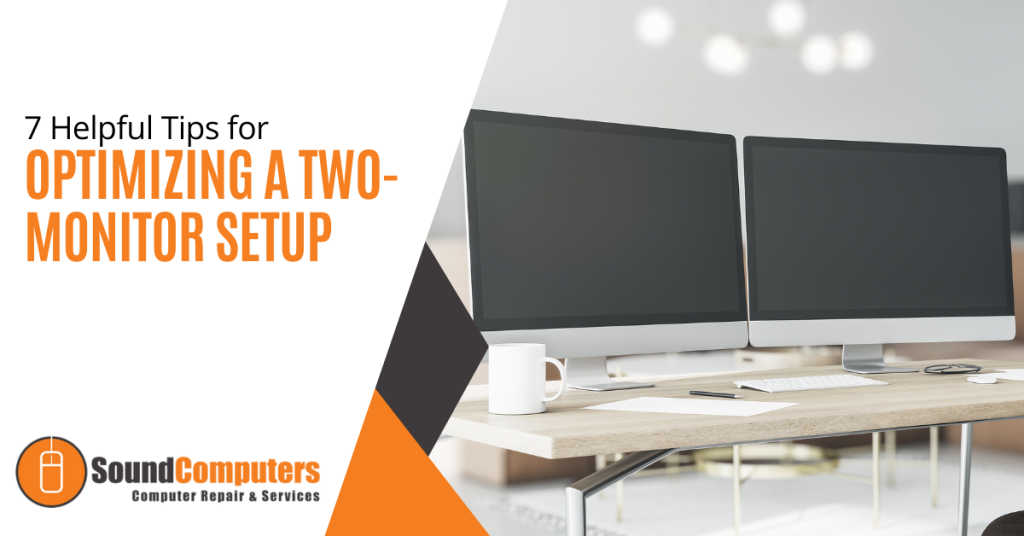
In today’s digital age, the demand for multitasking and productivity has led to the popularity of multi-monitor setups. With the ability to expand your workspace and have multiple applications visible simultaneously, a two-monitor setup has become a favored choice for professionals, gamers and creative individuals alike.
However, making the most of this setup requires more than just plugging in an extra screen. In this article, we will delve into some helpful tips for optimizing a two-monitor setup to enhance your efficiency, organization and overall user experience.
7 Helpful Tips for Optimizing a Two-Monitor Setup
The concept of using two monitors side by side is more than just a modern trend. It is a significant upgrade to how we interact with our digital tasks. Whether you are working on a complex project, managing multiple documents or engaging in immersive gaming, having two monitors can greatly streamline your workflow.
Without proper optimization, it is easy to become overwhelmed by the increased screen real estate. We will explore some strategies to harness the full potential of your dual monitor configuration.
1. Choosing the Right Monitors
Before delving into optimization, it is crucial to start with the right hardware. When selecting monitors for a dual setup, ensure that they are of the same size and resolution to prevent alignment and scaling issues. A uniform setup prevents awkward transitions between screens and provides a consistent visual experience.
Furthermore, consider the connectivity options available. Choose monitors that support the appropriate ports (HDMI, DisplayPort, etc.) for your computer’s graphics card. Some monitors also offer built-in USB hubs which can be handy for connecting peripherals and reducing cable clutter.
2. Optimal Physical Setup
The physical arrangement of your monitors plays a vital role in maximizing productivity and reducing strain. Position the monitors at eye level with the top of the screens aligned with your natural line of sight. This arrangement minimizes neck and back strain and ensures a comfortable and ergonomic workspace.
To avoid a distracting gap between screens, align them closely or invest in a dual-monitor stand to achieve a seamless visual transition. Experiment with different angles and orientations to find what suits your workflow best.
3. Graphics Card and System Requirements
While most modern computers can handle a dual-monitor setup, it is essential to ensure that your graphics card can support the additional workload. Graphics-intensive tasks such as gaming, video editing and 3D rendering may require a more powerful graphics card to ensure smooth performance across both screens.
4. Extended Desktop vs. Mirrored Display
One of the primary benefits of a two-monitor setup is the extended desktop feature. This mode allows you to treat each monitor as a separate workspace and effectively doubles your screen real estate. This is particularly useful for tasks that require multitasking such as comparing documents side by side, coding while referencing documentation or managing multiple chat applications simultaneously.
On the other hand, a mirrored display simply duplicates the content from one monitor to the other. While this might be helpful for presentations, it doesn’t leverage the full potential of a two-monitor setup in terms of productivity.
5. Customize Your Display Settings
Operating systems offer a range of display settings that can be customized to suit your preferences. Adjust the screen resolution, orientation and scaling to ensure a seamless visual experience between the two monitors. Additionally, explore options for arranging the monitors based on their physical placement. This customization can significantly enhance your workflow efficiency.
6. Optimizing Window Management
Efficient window management is crucial in a dual-monitor setup. Take advantage of features like snap and task view to organize and move windows between monitors effortlessly. Operating systems like Windows and macOS offer keyboard shortcuts to quickly move windows from one screen to another.
Consider using third-party window management tools that provide advanced features like window snapping, virtual desktops and customizable keyboard shortcuts. These tools can significantly improve your multitasking capabilities.
7. Utilize Taskbars and Docking Stations
Most operating systems support taskbars on both monitors to display open applications and enable easy switching. Customize your taskbar settings to show only relevant applications on each monitor, reduce clutter and enhance organization.
For laptops, docking stations offer a convenient way to transform your portable device into a powerful workstation. Docking stations provide additional ports such as USB, Ethernet and video outputs and allow you to connect multiple peripherals without constantly plugging and unplugging cables.
Tips for Maintaining a Productive and Comfortable Workflow
While optimizing the technical aspects of your two-monitor setup is essential, maintaining a productive and comfortable workflow also depends on your personal habits and workspace practices. Here are some additional tips to ensure an effective and enjoyable experience:
- Organize Your Desktop: Keep your desktop clutter-free by creating folders and using virtual desktops to organize different types of tasks.
- Adjust Lighting: Ensure proper lighting in your workspace to reduce eye strain and create a comfortable environment for extended use.
- Consider Keyboard and Mouse Placement: Position your keyboard and mouse in a way that promotes a neutral wrist position and reduces the risk of repetitive strain injuries.
- Regular Breaks: Remember to take regular breaks to stretch, rest your eyes and maintain overall well-being during extended work sessions.
Get Started Today
Optimizing a two-monitor setup requires a combination of hardware choices, physical arrangement and software customization. By choosing the right monitors, arranging them ergonomically, customizing display settings and implementing efficient window management techniques, you can harness the full potential of your dual monitor configuration. Additionally, adopting productive habits and maintaining a comfortable workspace contributes to an enhanced user experience.
If you are interested in exploring the possibilities of a two-monitor setup or need assistance with hardware recommendations and optimization, don’t hesitate to contact us at Sound Computers. We are here to provide expert guidance and support in creating an efficient and ergonomic dual-monitor workspace tailored to your needs. Your productivity deserves the best and we are here to help you achieve it.
